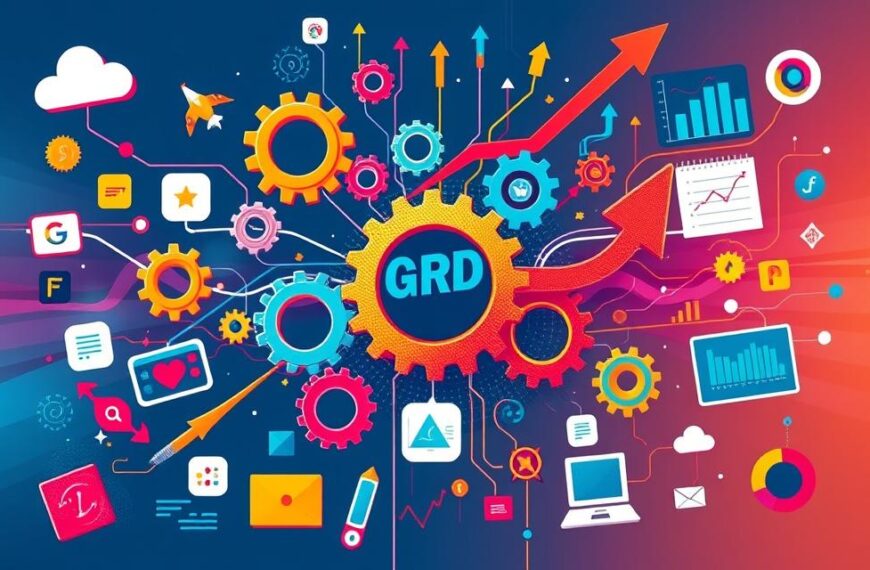The use of artificial intelligence (AI) in business is essential in our fast-moving world. It’s helping companies become more efficient and make better decisions. Thanks to progress in machine learning and deep learning, AI is now a key player in business. It processes huge amounts of data quickly, helping to make smart choices.
Businesses in many sectors are turning to AI to get ahead. They use chatbots and predictive analytics to improve customer service and operations. An interesting fact is that almost 90% of business leaders plan to spend more on AI, particularly for marketing.
For those keen on learning more about AI’s potential, resources like strategies for scaling with AI are very helpful. AI’s role in business is changing all the time, promising to revolutionise how we interact and operate in the future.
The Rise of AI in Modern Enterprises
The journey of AI has deeply changed modern businesses. It started in the 1980s, first helping in making decisions in finance and healthcare. Moving from simple tasks to more complex ones like machine learning was a key change. Now, businesses see AI as essential for staying ahead.
Understanding AI’s Evolution in Business
How companies use AI has changed, becoming a core part of their operations. A McKinsey report showed CEOs prefer cloud computing and new AI technologies. With AI investment possibly hitting $200 billion by 2025, tech and finance lead in embracing AI. Today, 80,000 companies make AI, bringing new opportunities, especially for smaller firms focusing on special markets.
Current Trends in AI Adoption
AI now greatly improves customer service. Tools like chatbots make help faster and easier. AI is also changing sales and marketing, making them smarter. It’s even reshaping hiring by making it easier and more efficient. AI helps companies foresee trends and fine-tune their work, boosting their success.
| AI Trend | Description | Impact on Enterprises |
|---|---|---|
| Generative AI | Integration of advanced algorithms that create new content and solutions. | Enhances creativity and operational capabilities. |
| Personalisation | Developing tailored experiences for consumers through data analytics. | Increases customer satisfaction and loyalty. |
| Automation | Streamlining routine tasks to improve efficiency. | Reduces human error and operational costs. |
| Predictive Analytics | Using historical data to forecast future trends and behaviours. | Informs strategic decision-making and reduces risks. |
How Is AI Used in Business Today
AI is rapidly reshaping modern business. Many companies now see its value for boosting efficiency and performance. Recent AI implementation statistics show wide adoption across sectors. This has led to big changes in how companies operate and interact with customers.
Key Statistics on AI Implementation
About 40% of businesses worldwide use AI technology, and another 42% are looking into it. According to McKinsey & Company, using AI in business has doubled since 2017. Also, 63% of those surveyed say they will invest more in AI in the coming three years.
Common Applications of AI Across Industries
Various business areas benefit from AI, such as:
- Accounting and finance
- Customer service
- Recruitment
- Cybersecurity
- Sales and marketing
- Supply chain and logistics
- Information technology (IT) operations
- Legal services
Companies like Société Générale view AI as key for their digital plans. AI improves customer interaction and decision-making, while making processes smoother. For instance, a South American telecom company saved USD 80 million. It used conversational AI to focus on high-value customers. Such AI applications show AI’s wide benefits.
The outlook for AI in business is strong. 77% of investing companies see great gains in efficiency. Meanwhile, 74% report better staff productivity, and 72% note higher customer happiness. By leveraging AI, businesses can transform their operations and achieve remarkable results.
To learn more about AI in database management, visit this link.
Global AI Adoption Rates and Trends
The global landscape of AI adoption shows big differences, mainly influenced by regional AI strategies. It’s interesting to see how companies of various sizes and in different places use AI technologies. As we move towards an AI-dominated future, it’s clear that both the region and organisation size are key factors in adoption rates.
Regional Variations in AI Usage
Different areas show unique trends in how they use AI. Some countries are leading the way with high usage rates, showing they’re keen to use AI’s power. Meanwhile, other areas are still catching up, with different levels of interest and use. This difference shows how complicated global adoption can be. Local things like infrastructure, money, and rules can really change how quickly AI is adopted. Below is a table with some important regional details:
| Region | AI Adoption Rate |
|---|---|
| India | 59% |
| United Arab Emirates (UAE) | 58% |
| United States (USA) | 33% |
Impact of Company Size on AI Adoption
How big a company is affects how much they use AI. Bigger companies are much more likely to use AI than smaller ones. This is because big companies have more resources to try out and use new tech. Many big businesses, especially those with over 10,000 workers, are using AI to get better and bring in new ideas. The data shows a clear connection between the size of a company and their AI strategies:
- 60% of business owners say AI will make them more productive.
- 79% of strategists think using AI is essential for future success.
- Over 80% of companies now see AI as an important part of their technology.
Real-World Examples of AI in Action
The use of AI is transforming lots of industries. This part looks at amazing AI stories from UPS, VideaHealth, and John Deere. They all highlight how AI changes their work for the better.
Case Study: UPS and Predictive Delivery Systems
UPS uses AI to stop package theft. They’ve created a delivery confidence score from 1 to 1,000. This system checks the risk for each parcel, helping UPS plan safer routes. Since about 26% of shoppers have had a package stolen, this method is key. It helps keep parcels safe and makes customers happy. It’s a great example of UPS AI delivery in action.
Case Study: VideaHealth’s AI Diagnostics
VideaHealth is using AI to get better at spotting dental issues. Their tech makes diagnosis more accurate, improving how patients are treated. This speeds up the diagnosis process and makes dental care more efficient. VideaHealth’s work is changing the game in dental health. It shows how AI can bring about wonderful results in healthcare.
Case Study: John Deere’s Agricultural Innovations
John Deere is using AI to farm smarter with agriculture. Their technology, like the See & Spray system, helps target weeds better. This smart use of resources means more crops and less weed killer used. It’s an innovative way to farm better. John Deere’s work is a clear example of how AI can improve farming.
These stories show AI’s flexibility and how it’s changing industries. They also highlight the digital revolution happening now. As more firms use AI, they can learn from key technologies making businesses better. This is how companies stay ahead in a fast-changing world.
The Economic Impact of AI on Businesses
AI is changing how businesses work across different sectors. It’s making companies more productive and efficient. This part looks at how AI tech might grow in the market. It also looks at how using AI can save money.
Projected Market Growth for AI Technologies
The AI market is set to grow a lot, with an expected 38.1% increase each year until 2030. This shows business leaders see how valuable AI is. 77% of companies use or plan to use AI. An impressive 83% say it’s very important for their future.
Many industries see AI as a chance to make more money. They think AI can increase how much they create by 1.5 percentage points in ten years.
Cost Savings and Efficiency Gains from AI Integration
Using AI has made a big difference for companies. 56% of them say it helps them work better. About 28% have cut costs thanks to AI. This has been especially true in banking and retail.
Banks might make an extra $1 billion from AI by 2035. Retail could see an increase of $20.05 billion by 2026.
Conclusion
The swift embrace of AI marks a significant step towards improved efficiency and innovation in the business world. By adopting AI, organisations in various fields can look forward to better productivity and lower costs. It is clear from the 69% of AI-driven chatbot users who report a positive experience, the benefits of AI are substantial.
Moreover, 61% of customers are ready to pay more for personalised services. However, only a quarter currently enjoy highly personalised interactions. This indicates a big opportunity for businesses to meet customer expectations.
The path forward for AI in business is not just about small upgrades. It’s about making big, transformative changes. For instance, top-notch supply chains use AI much more than their less successful counterparts. This shows AI’s essential role in staying ahead. Companies like Amazon show how AI can make processes faster and more productive by improving sorting and deliveries.
As AI technology gets better, businesses need to shape their AI strategies to meet their main aims. They should tackle privacy issues and use predictive analytics to handle today’s market complexities. To understand more about AI in businesses, look into resources about its practical uses and benefits in different areas.
FAQ
What is the current importance of AI in business?
AI is now vital in business, with 79% of strategists seeing its key role for future success. It’s used to boost efficiency, lower costs, and improve decision-making.
How many companies are currently using AI?
Around 40% of companies worldwide are using AI technologies. Another 42% are looking into how AI can help their work.
What are the most common applications of AI in various industries?
AI is mainly used in customer service, cybersecurity, and digital assistance. These uses help businesses run smoother and enhance customer interactions.
How does AI adoption vary by region?
AI use differs widely by region. India is at the forefront with a 59% rate, the UAE follows at 58%. The USA has a lower rate of 33%.
Does the size of a company influence its AI adoption?
Indeed, bigger companies adopt AI more than smaller ones. Over 60% of firms with over 10,000 employees use AI, showing size matters for AI usage.
Can you give examples of companies successfully implementing AI?
Companies like UPS, VideaHealth, and John Deere have seen success with AI. UPS reduces package theft, VideaHealth boosts dental care, and John Deere makes farming more efficient.
What is the projected market growth for AI technologies?
The AI market could hit
FAQ
What is the current importance of AI in business?
AI is now vital in business, with 79% of strategists seeing its key role for future success. It’s used to boost efficiency, lower costs, and improve decision-making.
How many companies are currently using AI?
Around 40% of companies worldwide are using AI technologies. Another 42% are looking into how AI can help their work.
What are the most common applications of AI in various industries?
AI is mainly used in customer service, cybersecurity, and digital assistance. These uses help businesses run smoother and enhance customer interactions.
How does AI adoption vary by region?
AI use differs widely by region. India is at the forefront with a 59% rate, the UAE follows at 58%. The USA has a lower rate of 33%.
Does the size of a company influence its AI adoption?
Indeed, bigger companies adopt AI more than smaller ones. Over 60% of firms with over 10,000 employees use AI, showing size matters for AI usage.
Can you give examples of companies successfully implementing AI?
Companies like UPS, VideaHealth, and John Deere have seen success with AI. UPS reduces package theft, VideaHealth boosts dental care, and John Deere makes farming more efficient.
What is the projected market growth for AI technologies?
The AI market could hit $1.85 trillion by 2030. This growth is fueled by a strong annual increase of 37.3%, reflecting AI’s expanding role in various industries.
How does AI contribute to cost savings in businesses?
AI has helped 28% of business leaders cut costs. This proves AI’s strong impact on boosting efficiency and saving money.
.85 trillion by 2030. This growth is fueled by a strong annual increase of 37.3%, reflecting AI’s expanding role in various industries.
How does AI contribute to cost savings in businesses?
AI has helped 28% of business leaders cut costs. This proves AI’s strong impact on boosting efficiency and saving money.


















